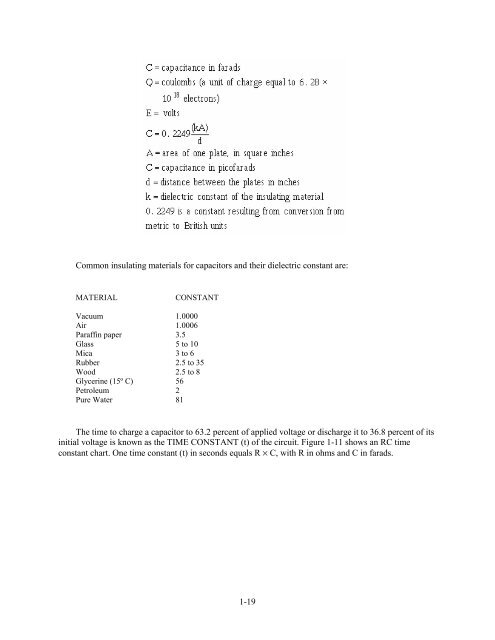Technicians Handbook - Historic Naval Ships Association
Technicians Handbook - Historic Naval Ships Association Technicians Handbook - Historic Naval Ships Association
drinks or stimulants. Get the victim to a medical facility as soon as possible. Cooling measures must becontinued while the victim is being transported.Heat ExhaustionHeat exhaustion (heat prostration or heat collapse) is the most common condition caused by workingor exercising in hot spaces. Heat exhaustion produces a serious disruption of blood flow to the brain,heart, and lungs. This causes the victim to experience weakness, dizziness, headache, loss of appetite, andnausea.Signs and symptoms of heat exhaustion are similar to those of shock: the victim will appear ashengray; the skin will be cold, moist, and clammy; and the pupils of the eyes may be dilated (enlarged). Thevital (blood pressure, temperature, pulse, and respiration) signs usually are normal; however, the victimmay have a weak pulse together with rapid and shallow breathing. Body temperature may be belownormal.You should treat heat exhaustion victims as if they were in shock. Loosen the clothing, apply coolwet cloths, move the victim to either a cool or an air-conditioned area, and fan the victim. Do not allowthe person to become chilled. If the victim is conscious, administer a solution of 1 teaspoon of saltdissolved in a quart of cool water. If the victim vomits, do not give any more fluids. Transport the victimto a medical facility as soon as possible.HELPFUL INFORMATIONThe second part of this handbook has been compiled to provide the technician with a collection ofhelpful information. Included are many commonly used formulas, data tables, and general maintenancehints used in, with, and around electricity.BASIC ELECTRICAL FORMULASBasic electrical formulas are included to aid you in solving electrical problems. These formulas arefor capacitance, current, inductance, power, reactance, impedance, resistance, voltage, and transformers.Additional formulas can be found in the appropriate NEETS module.CapacitanceThe property of an electrical device to store energy is CAPACITANCE. This energy is stored in away to oppose a change in voltage. A CAPACITOR is used to store this electrical energy. The FARADis the basic unit of measurement of capacitance.Formulas for capacitance:1-18
Common insulating materials for capacitors and their dielectric constant are:MATERIALCONSTANTVacuum 1.0000Air 1.0006Paraffin paper 3.5Glass 5 to 10Mica 3 to 6Rubber 2.5 to 35Wood 2.5 to 8Glycerine (15º C) 56Petroleum 2Pure Water 81The time to charge a capacitor to 63.2 percent of applied voltage or discharge it to 36.8 percent of itsinitial voltage is known as the TIME CONSTANT (t) of the circuit. Figure 1-11 shows an RC timeconstant chart. One time constant (t) in seconds equals R × C, with R in ohms and C in farads.1-19
- Page 1 and 2: SPECIAL PUBLICATIONSeptember 1998Na
- Page 3 and 4: PREFACESpecial Publications (SPs) a
- Page 5 and 6: TABLE OF CONTENTSCHAPTERPAGE1. The
- Page 7 and 8: Module 11, Microwave Principles, ex
- Page 9: Student CommentsCourse Title:NEETS
- Page 12 and 13: • Be cautious when working in voi
- Page 14 and 15: Electric ShockElectric shock may ca
- Page 16 and 17: In this situation, the immediate ad
- Page 18 and 19: Lean or rock forward with elbows lo
- Page 20 and 21: possible) over the wound and firmly
- Page 22 and 23: (1) NEAREST THE WOUND and (2) BETWE
- Page 24 and 25: Shock• Be sure you draw the tourn
- Page 26 and 27: Liquids should be administered spar
- Page 30 and 31: Figure 1-11.—RC time constants.Fi
- Page 32 and 33: Ac current formulas are:Ohm's law f
- Page 34 and 35: Parallel inductors without coupling
- Page 36 and 37: Another way to calculate reactive p
- Page 38 and 39: ResistanceRESISTANCE is the opposit
- Page 40 and 41: Since:Transformer power:1-30
- Page 42 and 43: WARNINGRf voltages may be induced i
- Page 44 and 45: Alpha is always less than 1 for a c
- Page 46 and 47: WavelengthCAUTIONBecause vacuum tub
- Page 48 and 49: Minimum radar range = (pulse width
- Page 50 and 51: Log or dBGain or mw11 12.510 109 88
- Page 52 and 53: Table 1-1.—CB Style Capacitor Par
- Page 54 and 55: Table 1-3.—CYR10 Style Capacitor
- Page 56 and 57: Figure 1-16.—Ceramic capacitor co
- Page 58 and 59: Table 1-4.—Principal Applications
- Page 60 and 61: Figure 1-18.—Resistor color code.
- Page 62 and 63: MilitaryspecificationMIL-R-39005MIL
- Page 64 and 65: Figure 1-19.—Color code for trans
- Page 66 and 67: Figure 1-21.—Transistor lead iden
- Page 68 and 69: numbers and part numbers can be fou
- Page 70 and 71: SizeTable 1-10.—Current-Carrying
- Page 72 and 73: Jan TypeOverallDiameter (ins)Table
- Page 74 and 75: Table 1-13.—MS Connector Identifi
- Page 76 and 77: Figure 1-23.—Insert arrangements
Common insulating materials for capacitors and their dielectric constant are:MATERIALCONSTANTVacuum 1.0000Air 1.0006Paraffin paper 3.5Glass 5 to 10Mica 3 to 6Rubber 2.5 to 35Wood 2.5 to 8Glycerine (15º C) 56Petroleum 2Pure Water 81The time to charge a capacitor to 63.2 percent of applied voltage or discharge it to 36.8 percent of itsinitial voltage is known as the TIME CONSTANT (t) of the circuit. Figure 1-11 shows an RC timeconstant chart. One time constant (t) in seconds equals R × C, with R in ohms and C in farads.1-19



